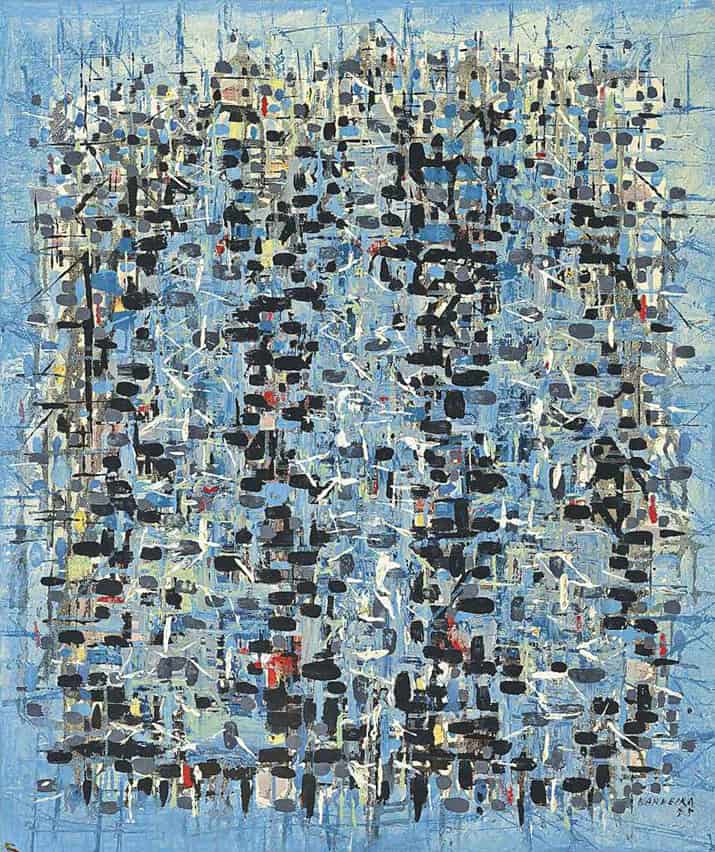
Antonio Bandeira
We Buy Antonio Bandeira Paintings
Click To Get A Valuation Of Your Antonio Bandeira Painting. You’ll get a confidential fair market valuation of your painting and its marketability. We pay cash for paintings by Antonio Bandeira and also take consignments to the gallery.

Antonio Bandeira
Title: Blue Streets 1955
Oil on canvas, 26 x 22 in
Signature: Inscribed and Signed
ANTONIO BANDEIRA BIOGRAPHY
Antonio Bandeira (Brazil 1922 – France 1967)
Antonio Bandeira was a Brazilian artist born in 1922 in Fortaleza, Brazil. He was among the top Brazilian abstract artists of the 1950s and 1960s. He captivated collectors with his vibrant Lapis Lazuli blue and grid-like geometrical compositions. Antonio Bandeira is one of the ten great Brazilian painters and the greatest of his generation. His paintings have been in many exhibitions and are in private collections and museums.
As an artist Bandeira was unique amidst all the abstraction in vogue in Brazil in the 1950s and 1960s. His artwork uses two opposing pairs: 1) Structural grids & informalism/tachisme; and 2) Figuration & abstractionism. Many of his “abstract” paintings have titles such as, “City,” “View” or “Tree”. It’s also important to note that Antonio Bandeira was a master colorist.
Early Years
He began painting as a self-taught artist. In the first half of the 1940s, while still in his native state of Ceará, he was very active in the introduction of modernist ideas. In 1945 he moved to Rio de Janeiro and in 1946 to Paris, where he spent most of the rest of his life. He painted with Mário Baratta (1915-1983), among others, and helped to create the Cultural Center of Fine Arts – CCBA, which gave rise to the Sociedade Cearense de Artes Pláticas – SCAP in 1943.
In Paris, Antonio Bandeira studied at the Ecole Supérieure de Beaux-Arts and at the Académie de la Grande Chaumière. In these early years he painted landscapes and portraits, combining elements of Surrealism and Expressionism. He later adopted a gestural abstraction that maintained its links with the outside world through analogies established in poetic titles.
In the early days of his time in France (1947 – 1948), he participated in two important events: the Salon d’Automne and the Salon d’Art Libre. Antonio Bandeira was the only Brazilian artist to move to Paris a year after the end of WWII and to integrate with tachiste artists. He also formed friendships with fellow artists Camille Bryen (1907 – 1977) and Wols (1913 – 1951). The three artists formed the Banbryols Group (a combination of their surnames) which lasted from 1949 to 1951.
Return To Brazil
Bandeira returned to Brazil in 1951. There he settled in the studio of his sculptor friend José Pedrosa (1915-2002), where the artist Milton Dacosta (1915-1988) also worked. In 1952, he created a mural for the Institute of Architects of Brazil – IAB / SP, in São Paulo. He returned to Paris in 1954 due to the Fiat Award, obtained at the 2nd International Biennial of São Paulo, but still exhibited in Brazil.
In 1957, during his first solo exhibition at New York City’s Gallery 75, the local press described the cosmopolitan Fortaleza-born artist as “an abstract expressionist from Paris, born in Brazil.” In his lifetime, the artist participated in the Venice Biennale (1952, 1960 and 1964) and at the São Paulo Bienal (1951, 1953, 1955, 1959 and 1961.) Bandeira designed the official poster for the 1953 edition, its second iteration.
Then in 1958 he made a panel for the Palais des Beaux-Arts in Brussels. And in 1961 he created a very large triptych for the University of Ceará. In his large-scale paintings, such as Big City Illuminated (1953; Rio de Janeiro, Mus. N. B.A.), and in his equally characteristic tiny gouaches, he directed the dynamic energy of dots, lines, blots and drops of color with a centripetal force. His technique organized what otherwise could have been random gestures into webs of regular and sometimes geometrically based structures.
Artist Antonio Bandeira remained in Europe until 1959. During this time he traveled through England and Belgium, where, in 1958, he held a panel for the Palais des Beaux-Arts. Upon returning to Brazil he has was very active and participated in several important exhibitions. At the same time he exhibited in Paris, Munich, Verona, London and New York. Certainly Bandeira had collectors abroad, but his largest market was in Brazil.
Antonio Bandeira Painting Style
Antonio Bandeira had a very diversified painting style. He worked with gouache, watercolor and oil paint, and experimented with natural paint extracted from tropical fruit, such as the cashew apple. On some of his paintings he glued beads on the surface of the canvas. He employed non-traditional media such as paper clay, papier-maché, Styrofoam and jute. He explored anything he had at arm’s length to stamp the canvas to achieve unique marks and textures.
In 1961, Antonio Bandeira edited an album of his poems and lithographs while João Siqueira made a short film about his work. Bandeira returned to Paris in 1965, where he remained until his death. Antonio Bandeira died in Paris on October 1967 at the age of 45.